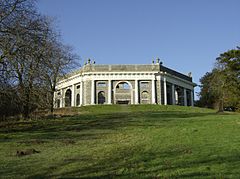West Wycombe, Buckinghamshire
| West Wycombe | |
|---|---|
 The Mausoleum on West Wycombe Hill |
|
| West Wycombe shown within Buckinghamshire | |
| Population | 1,345 (2011 Census) |
| OS grid reference | SU830945 |
| Civil parish |
|
| District | |
| Shire county | |
| Region | |
| Country | England |
| Sovereign state | United Kingdom |
| Post town | High Wycombe |
| Postcode district | HP14 |
| Dialling code | 01494 |
| Police | Thames Valley |
| Fire | Buckinghamshire |
| Ambulance | South Central |
| EU Parliament | South East England |
| UK Parliament | |
West Wycombe is a small village situated along the A40 road, three miles west of High Wycombe, Buckinghamshire, England.
The historic village is largely a National Trust property and receives a large annual influx of tourists – being the site of West Wycombe Park, West Wycombe Caves and the Mausoleum on top of West Wycombe Hill. The Mausoleum and Golden Ball above West Wycombe village are impressive local landmarks, visually dominating the village and local landscape for miles surrounding.
West Wycombe Park, Caves, Mausoleum and St Lawrence's Church were all constructed in the mid-18th century by Sir Francis Dashwood, founder of the Dilettanti Society and co-founder of the notorious Hellfire Club.
The hill above West Wycombe (now the site of St Lawrence's Church and the Mausoleum) has been continuously inhabited for centuries. A Bronze Age settlement is widely believed to have existed here, and research suggests there was a pagan temple in a similar style to Stonehenge. The earliest known settlement is an Iron Age ditch and rampart contour camp dating from the fourth or fifth century BC. A Roman settlement later occupied West Wycombe Hill, and local historians believe a temple was constructed here (though the exact site remains unknown).
The next major influence on West Wycombe was the Saxons. The hillside was once again occupied, and the newly established settlement was named Hæferingdune (Hill of Hæfer's people in Old English). The name later evolved into Haveringdon. The site retained religious importance: a church is said to have been erected by St Birnius (who later became the bishop of the West Saxons in AD 635).
A Norman watch tower is also said to have been built on top of the hill.
Haveringdon's population is believed to have been greatly reduced by the Bubonic Plague (Black Death) in the 1340s. By the 18th century the village had been resited in the valley along the Oxford Road, and renamed due to its geographical features and position: "West" because it was west of High Wycombe. Both settlements are in the Wye Valley and the word "Combe" derives from the Old English/Brythonic word for "valley". According to local records there were just two ratepayers left in Haveringdon in the 19th century.
...
Wikipedia

